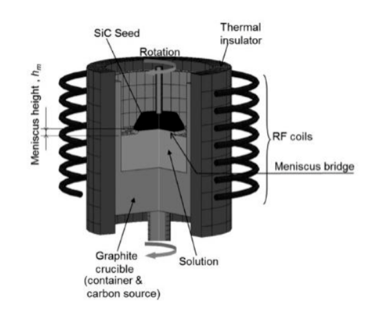
- English
- Español
- Português
- русский
- Français
- 日本語
- Deutsch
- tiếng Việt
- Italiano
- Nederlands
- ภาษาไทย
- Polski
- 한국어
- Svenska
- magyar
- Malay
- বাংলা ভাষার
- Dansk
- Suomi
- हिन्दी
- Pilipino
- Türkçe
- Gaeilge
- العربية
- Indonesia
- Norsk
- تمل
- český
- ελληνικά
- український
- Javanese
- فارسی
- தமிழ்
- తెలుగు
- नेपाली
- Burmese
- български
- ລາວ
- Latine
- Қазақша
- Euskal
- Azərbaycan
- Slovenský jazyk
- Македонски
- Lietuvos
- Eesti Keel
- Română
- Slovenski
- मराठी
- Srpski језик
What is liquid phase epitaxy?
2023-08-11
Liquid-phase epitaxy (LPE) is a method to grow semiconductor crystal layers from the melt on solid substrates.
The unique properties of SiC make it challenging to grow single crystals. The conventional growth methods used in the semiconductor industry, such as the straight pulling method and the descending crucible method, cannot be applied due to the absence of a Si:C=1:1 liquid phase at atmospheric pressure. The growth process requires a pressure greater than 105 atm and a temperature higher than 3200°C to achieve a stoichiometric ratio of Si:C=1:1 in the solution, as per theoretical calculations.
The liquid phase method is closer to the thermodynamic equilibrium conditions and is able to grow SiC crystals with better quality.

The temperature is higher near the crucible wall and lower at the seed crystal. During the growth process, the graphite crucible provides a C source for crystal growth.
1. The high temperature at the crucible wall results in high solubility of C, leading to fast dissolution. This leads to the formation of a C saturated solution at the crucible wall through significant C dissolution.
2. The solution with a considerable amount of dissolved C is transported towards the seed crystal's bottom by the auxiliary solution's convection currents. The seed crystal's lower temperature corresponds to a decrease in C solubility, leading to the formation of a C-saturated solution at the low-temperature end.
3. When the supersaturated C combines with the Si in the auxiliary solution, SiC crystals grow epitaxially on the seed crystal. As the supersaturated C precipitates, the solution with convection returns to the crucible wall's high-temperature end, dissolving C and forming a saturated solution.
This process repeats multiple times, eventually leading to the growth of finished SiC crystals.




